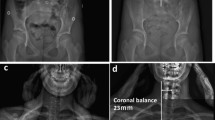Abstract
Purpose
Authors examined a case series of patients younger than 18 years old who had sustained a traumatic thoracolumbar spine fracture to evaluate radiological and clinical findings of coronal spinal balance, after conservative treatment.
Methods
From 1996 to 2014, a tricentric cohort of 48 patients with an average age of 12 years was radiographically reviewed at 50 months. Cobb angle of fractured vertebra and regional Cobb angle were measured both at baseline and follow-up. Analyses were done according to initial Risser grade, number of fractures and level of injury.
Results
There was a total of 11 scoliosis. In group with Risser grade 3 or above, with a single vertebral fracture and lumbar fracture, final regional Cobb angle was statistically higher than initial regional Cobb angle.
Conclusions
The prevalence of scoliosis in our population is higher than those of idiopathic scoliosis; Risser grade 3 or above, lumbar fracture and a single fracture seem to account for more severe coronal deformation.



Similar content being viewed by others
References
Parisini P, Di Silvestre M, Greggi T (2002) Treatment of spinal fractures in children and adolescents: long-term results in 44 patients. Spine 27:1989–1994
Rush JK, Kelly DM, Astur N, Creek A, Dawkins R, Younas S et al (2013) Associated injuries in children and adolescents with spinal trauma. J Pediatr Orthop 33:393–397
Sayama C, Chen T, Trost G, Jea A (2014) A review of pediatric lumbar spine trauma. Neurosurg Focus 37:E6
Karlsson MK, Moller A, Hasserius R, Besjakov J, Karlsson C, Ohlin A (2003) A modeling capacity of vertebral fractures exists during growth: an up-to-47-year follow-up. Spine 28:2087–2092
Vaccaro AR, Silber JS (2001) Post-traumatic spinal deformity. Spine 26(24 Sl):111–118
Lonstein JE (1995) Idiopathic Scoliosis. In: Moe’s textbook of scoliosis and other spinal deformities, 3rd edn. WB Saunders, Philadelphia, pp 219–221
Konieczny MR, Senyurt H, Krauspe R (2013) Epidemiology of adolescent idiopathic scoliosis. J Child Orthop 7:3–9
De Souza FI, Di Ferreira RB, Labres D, Elias R, De Sousa AP, Pereira RE (2013) Epidemiology of adolescent idiopathic scoliosis in students of the public schools in Goiania-GO. Acta Ortop Bras 21:223–225
Kane WJ, Moe JH (1970) A scoliosis-prevalence survey in Minnesota. Clin Orthop Rel Res 69:216–218
Gnanenthiran SR, Adie S, Harris IA (2012) Nonoperative versus operative treatment for thoracolumbar burst fractures without neurologic deficit: a meta-analysis. Clin Orthop Rel Res 470:567–577
Zhang H, Sucato DJ (2008) Unilateral pedicle screw epiphysiodesis of the neurocentral synchondrosis. Production of idiopathic-like scoliosis in an immature animal model. J Bone Joint Surg Am 90:2460–2469
Braun JT, Ogilvie JW, Akyuz E, Brodke DS, Bachus KN, Stefko RM (2003) Experimental scoliosis in an immature goat model: a method that creates idiopathic-type deformity with minimal violation of the spinal elements along the curve. Spine 28:2198–2203
Mente PL, Aronsson DD, Stokes IA, Iatridis JC (1999) Mechanical modulation of growth for the correction of vertebral wedge deformities. J Orthop Res 17:518–524
Mente PL, Stokes IA, Spence H, Aronsson DD (1997) Progression of vertebral wedging in an asymmetrically loaded rat tail model. Spine 22:1292–1296
Stokes IA (1997) Analysis of symmetry of vertebral body loading consequent to lateral spinal curvature. Spine 22:2495–2503
Stokes IA, Spence H, Aronsson DD, Kilmer N (1996) Mechanical modulation of vertebral body growth. Implications for scoliosis progression. Spine 21:1162–1167
Schlosser TP, van Stralen M, Brink RC, Chu WC, Lam TP, Vincken KL et al (2014) Three-dimensional characterization of torsion and asymmetry of the intervertebral discs versus vertebral bodies in adolescent idiopathic scoliosis. Spine 39:1159–1166
Modi HN, Suh SW, Song HR, Yang JH, Kim HJ, Modi CH (2008) Differential wedging of vertebral body and intervertebral disc in thoracic and lumbar spine in adolescent idiopathic scoliosis—a cross sectional study in 150 patients. Scoliosis 3:11
Kerttula LI, Serlo WS, Tervonen OA, Paakko EL, Vanharanta HV (2000) Post-traumatic findings of the spine after earlier vertebral fracture in young patients: clinical and MRI study. Spine 25:1104–1108
Moller A, Hasserius R, Redlund-Johnell I, Ohlin A, Karlsson MK (2007) Nonoperatively treated burst fractures of the thoracic and lumbar spine in adults: a 23- to 41-year follow-up. Spine J 7:701–707
Bjorck-van Dijken C, Fjellman-Wiklund A, Hildingsson C (2008) Low back pain, lifestyle factors and physical activity: a population based-study. J Rehabil Med 40:864–869
Grauers A, Topalis C, Moller H, Normelli H, Karlsson M, Danielsson A, et al (2014) Prevalence of back problems in 1069 adults with idiopathic scoliosis and 158 adults without scoliosis. Spine (Epub ahead of print)
Fontecha CG, Balague F, Pellise F, Rajmil L, Aguirre M, Pasarin M et al (2011) Low back pain in adolescents: is quality of life poorer in those seeking medical attention? Spine 36:1154–1161
Mahan ST, Mooney DP, Karlin LI, Hresko MT (2009) Multiple level injuries in pediatric spinal trauma. J Trauma 67:537–542
Conflict of interest
None.
Author information
Authors and Affiliations
Corresponding author
Rights and permissions
About this article
Cite this article
Angelliaume, A., Bouty, A., Sales De Gauzy, J. et al. Post-trauma scoliosis after conservative treatment of thoracolumbar spinal fracture in children and adolescents: results in 48 patients. Eur Spine J 25, 1144–1152 (2016). https://doi.org/10.1007/s00586-014-3744-6
Received:
Revised:
Accepted:
Published:
Issue Date:
DOI: https://doi.org/10.1007/s00586-014-3744-6




